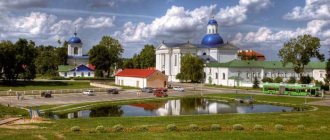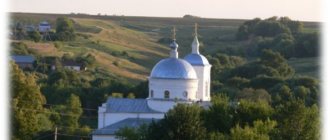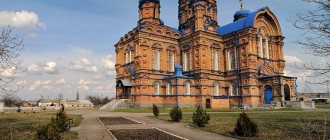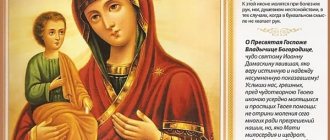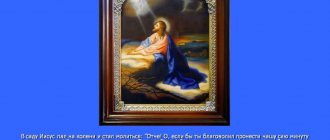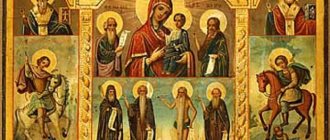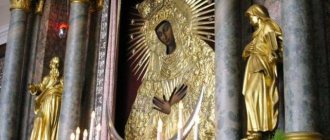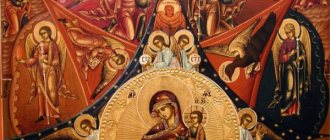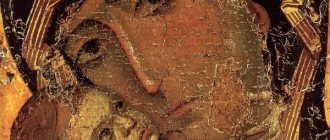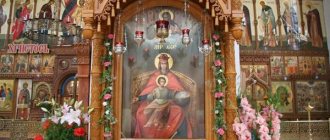5
(1)
The Icon of the Mother of God “Rejoices in You” is a very famous image in Orthodoxy. He reminds believers of the all-powerful help of the Mother of God. The image appeared to people in the 15th century, surprising people with its miraculous power. This is the only face that was created for prayers of thanks to the Mother of God. If near other images people ask for healing and solutions to problems, then near the icon “Rejoices in You” people praise the Virgin Mary. Speeches of thanks help to cleanse the souls of believers.
Story
The creation of the icon was based on the proclamation “She rejoices in You, O Blessed One.” The history of the events that led to the creation of the image is very unusual. Its reality is hard to believe. At the end of the 8th century, Emperor Leo III issued a strict decree prohibiting the worship of Christian faces. All icons and frescoes were ordered to be destroyed. John of Damascus, known for his Christian virtues, spoke out against such acts. He began sending letters to people about defending icon veneration. Not everyone liked his active position. Leo III was frankly hindered by his activities.
Photo 1. John of Damascus experienced the divine healing power of the Mother of God.
But the emperor could not openly kill a citizen of a foreign state, so he decided to act by cunning. On behalf of the icon painter, he wrote a forged document, which stated that the priest had allegedly prepared a plot to overthrow the caliph, and was inviting the emperor to speak in his support. The document was sent to the caliph's palace. The latter became very angry and ordered John to be punished. The caliph did not begin to understand the situation, although until that moment the ruler had no reason not to trust the icon painter. John Mansura was unfairly accused of treason. And then they cut off his hand as punishment.
The Archbishop of Damascus was saddened by the fate of John and did not leave his side after the execution. At his request, he brought the man his severed hand. John tore off the bandage and put his hand to the wound, wrapping everything with a towel. In a feverish state, the icon painter extended his hand to the icon of the Mother of God, asking her for healing. All night John screamed and prayed until he fell from pain and exhaustion. Half asleep, he felt eyes on him. Opening his eyes, the icon painter saw the light that poured from the holy image. The Most Pure Virgin looked at him. Then John heard a voice that told him that the Mother of God hears all the prayers coming from sincere believers. The Mother of God told the icon painter that she had healed his hand.
In a state of bliss, John took off the bloody towel. Then he saw a red scar on his hand at the junction of injured tissues. The icon painter tried to move his fingers and through the pain he felt that they were working. Happy John began to read a prayer of thanks. After the healing, the icon painter promised to paint icons and serve God. He kept his promise.
The history of the icon “Life-Giving Spring”
The chronicle of the appearance of the holy image goes back to the fifth century; for that matter, there was a grove near Constantinople, which, according to legend, was dedicated to the sacredly revered Virgin Mary.
A spring flowed in this grove, memorable for its miracles, but over time it was hidden behind thickets of bushes and mud and gradually completely disappeared. In the year 450, a warrior named Levusya Markell (who later became emperor) happened to meet a lost blind man in this grove; a soldier helped him find a path and sat him down in the shade. And with my own eyes (to see) he went for water to quench the thirst of the exhausted traveler. For no apparent reason, Leo heard that the Ever-Virgin herself was calling him, who gave him the task of discovering an abandoned spring and bringing mud from it onto the eyes of the blind man.
Markell did everything he was told and a miracle happened - the spontaneous one began to see again. The Mother of God also told Leo that he would sit on the imperial throne; this, in addition, became true after seven years. If the promise came true, Leo Markell remembered the defense of the Mother of God and gave the order to ennoble the source, establish a circle of stones around it and build a church on it in honor of the Virgin Mary.
The sacred key of the emperor was given the title “Life-Giving Spring”, because it began to manifest the miraculous be-be of the Mother of God. They also named a new icon, painted by a specialist for this temple.
In the 6th century, Emperor Justinian the Great also had to drink water from a healing spring, which cured him of a serious illness. To celebrate, he ordered another temple to be built next to the one erected by Leo, and a monastery was organized with him.
In the 15th century, the Byzantine Empire collapsed from time to time, and the tabernacle suffered a similar fate - it was destroyed by Muslims. Then a small church was built in its place, which was also demolished in 1821, and the source itself was filled up. Although the Orthodox removed the ruins, cleaned the source and again began to abuse its healing water. Subsequently, a new church was built on this site, at which a hospital with an almshouse was organized.
The figure of the Mother of God “Life-Giving Spring” was greatly revered by the ancient Russians. For example, in the Sarov desert, a church was built to honor this image. All Orthodox Christians stricken with illnesses went, exactly on the advice of St. Seraphim of Sarov, to offer prayers at the miraculous image, and their illnesses miraculously passed away.
Until now, the icon of the “Life-Giving Spring” has not lost its popularity. In particular, on Friday of Bright Week, when the Divine service ends in Christian churches, it is customary to perform a water-blessed prayer service at this image. And the moisture consecrated at the Liturgy is used by believers to sprinkle their gardens and vegetable gardens.
What destinies are depicted in this image?
The shrine shows us the Queen of Heaven of God sitting in the font, holding the baby Jesus in her arms. At first, the source was not applied to the sacred object, but later the composition was supplemented with a Vial (chalice). And again, a little later, the icon is depicted with a pond and a fountain.
Letter of recommendation from an icon, how can she help?
Many personnel are interested in the characteristics of the “Life-Giving Spring” icon and how it can help. It should be noted that the appearance of the Mother of God has a much deeper characteristic and meaning than the healing properties of holy water alone.
He personifies outwardly the Saint herself, who in her womb bore the Savior to the sum of humanity and gave eternal life to all who believe in him and in his Father and keep faith in both in their souls.
Your Grace may come across the statement that God acts as our whole Life, and the hearth represents the feminine principle, personifies the image of the Mother of God. For this reason, the Russian icon-painting tradition gives this face the name “Istochnaya”. This means that this is the personification of the beginning from which female life flows (the festive kontakion designates it as the Water Savior alias the God-Blessed Source).
The image contributes to the healing of the spirit and body of all people living on the earth like a real caring mother who is guarding the entire human race. Next, let’s look at what problems this icon will definitely help you with.
The meaning of the icons
Initially, the early temples did not have any images. People read prayers with detachment. But over time, people's faith began to weaken. Christians needed a visual image to focus on during prayer. This is how the first images appeared. When painting icons, artists convey the real sensations of Christ, who is driven by the power of love for people. Through the power of the image, grace is transmitted to those who pray. Therefore, now icons are an integral part of faith. They pray before them and healing comes from them. Modern churches cannot be imagined without images.
Photo 2. The meaning of the icon is fundamentally different from other images.
It is very important to understand that in the Christian faith it is not the image itself that is worshiped, but a certain person depicted on the icon. All believers share this opinion.
Description of the icon
The icon “Rejoice in You” depicts the Mother of God on the throne with a baby in her arms. Looking at the image, believers’ hearts are filled with joy, which is difficult to convey in words.
John of Damascus, in a prayer of thanksgiving in honor of the Mother of God, conveyed those feelings that overwhelm believers. In his opinion, people, birds and all living things experience blessed joy. In the background of the image is a temple. And in front of him is the throne. The Virgin Mary is dressed in burgundy clothing. With both hands she hugs the baby sitting in her arms. Standing near the throne is St. John, who is the author of the prayer. Its first lines served as the basis for the name of the image. At the foot of the throne are shown the holy martyrs surrounding the Mother of God. The figure of the Mother of God is depicted in a luminous sphere, in which she descended from heaven along with the angels. People around the Mother of God glorify her.
Photo 3. The history of the icon is connected with the name of John of Damascus.
It is worth saying that the face “Rejoices in You” is of great importance for all believers. After all, all Christians understand how important it is not only to pray for help, but also to express their gratitude to the Lord.
The name and exact date of creation of the icon have not been preserved to this day.
Iconography
The type of icon that we see today appeared in a later period. Initially, the image was completely different. The icon typically depicted the Mother of God with Jesus in the style of “Tenderness” faces. Later, divine figures were retained as a basis on the lists. As for other elements, they were added gradually in the process of understanding the miraculous events.
Photo 3. The image of the icon has undergone changes over time.
At the level of the head of the Mother of God and the baby, on both sides of the canvases you can see heavenly messengers with open arms. At the top of the icon the Almighty is shown surrounded by Archangels, symbolizing chants directed to God. Something has also changed in the depiction of the main figures. The Mother of God and the baby acquired new features that speak of their royal greatness. They wear crowns on their heads, and their gaze is directed at the scroll in the hands of the baby. The prayer book is an affirmation that Jesus is the true ruler of the spirit world.
In iconographies there are also other types of the “It is Worthy to Eat” icon. The plot of such images demonstrates saints who read a prayer service before the Mother of God. This type of icon was actively used in ancient Russian art of the 17th century.
In terms of the style of writing, the shrine is very reminiscent of the frescoes “He rejoices in you,” which were often placed on altars:
- The Virgin Mary is depicted in full height. She has a baby in her arms.
- The figure of the Mother of God is surrounded by a mandala, which symbolizes the heavenly abode.
- Above Christ and the Virgin Mary in the clouds is the Almighty.
- On both sides there are saints and angels in hierarchy.
The text of the song “It is worthy to eat” is certainly written down next to the image.
Very often, faces were applied to vessels, which are usually called panagiars. Prosphora consecrated during the service were kept in them.
Currently, in our churches you can see numerous lists of the “Merciful” image. The icon can be seen in St. Petersburg on the territory of Galernaya Harbor and in the Trinity-Sergius Lavra in Moscow. The lists were brought to the temples from the Holy Mountain.
John of Damascus: historical background
The Monk John of Damascus was born at the end of the 7th century in Damascus (one of the cities of Syria). He went down in history as a hymnographer, philosopher and theologian. John served under the Damascus caliphate. He used all his influence for the benefit of the Christian faith. Throughout his life he wrote many dogmatic works. However, he became famous thanks to iconoclasm. The story of the appearance of the “Three-Handed” icon is connected with his name. John is the author of the work “The Source of Knowledge.” In addition, he wrote a number of hymns about the Mother of God, including “Rejoices in You.” The canons about the Nativity of Christ, Easter and Epiphany belong to his pen.
Photo 4. At the icon “Rejoices in You” it is customary to praise the Mother of God.
Leaving service for the good of the state, John moved to Palestine, where he took monastic vows in a temple near Jerusalem. There he served God until his death. It is known that his relics were transported to Constantinople. Now there are particles of them in the Monastery of Saint Sava, the Monastery of St. John the Theologian and the Monastery of St. George. John's Memorial Day is celebrated on December 17th.
Literature
| Personalities | Saint Joachim and Saint Anna • Righteous Elizabeth • Joseph the Betrothed • Jesus Christ • John the Evangelist |
| Places and objects | Jerusalem • House of Joachim and Anna (Orthodox, Catholic) • Second Temple • Nazareth • House of Our Lady of Loreto • City of Juda • Spring of the Virgin Mary • Bethlehem • Cave of the Nativity • Milk Cave • Mataria • El Minya • Cana of Galilee • Zion's Upper Room • House The Virgin Mary in Ephesus • House of St. John the Evangelist • Tomb of the Virgin Mary • Robe of the Virgin Mary • Belt of the Blessed Virgin Mary • Lot of the Virgin Mary |
| Iconography | Orthodox • Catholic • Iconography of the Life of the Virgin Mary |
| Dogmas and holidays | Feasts of the Virgin Mary • Immaculate Conception of the Virgin Mary • Praise of the Blessed Virgin Mary • Protection of the Blessed Virgin Mary • Cathedral of the Blessed Virgin Mary • Blessed Virgin Mary, Queen of Poland |
| Prayers | Ave Maria • Hymn to the Blessed Virgin Mary • Theotokos antiphons • Worthy to eat • Rejoices in You • Rosary • Litany of the Blessed Virgin Mary • Agni Parthena |
Meaning of the icon
Not all believers understand the difference between the icon and other images of the Mother of God. In front of other faces, people usually offer prayers, putting their requests into them. As for the face “Rejoices in You”, before her they glorify and praise the Queen of Heaven, who unites the Kingdom of Heaven and the earthly world. The glorification of the Mother of God also comes from both the angels and the saints in the icon. The meaning of the image lies in the universal glorification of the Mother of God. The hymn of John of Damascus helps to praise the deeds of the Mother of God. It is not prayers for help that rise to the face of the Mother of God, but the gratitude of those who are in heaven and earth. This is its fundamental difference from other icons.
He rejoices in You
Size: 39 x 31
Material: wood, gesso, tempera
Persons: Mother of God, Child, Angels, King David, John the Baptist, Saints, The Prudent Thief
Specifying dating: 17th century. First half
Century: 17
Country Russia
Storage location: State Historical Museum, Moscow
Iconography, category: Mother of God
Image type: Throne
Iconographic information
Among the icons that embody images of chants and prayers in honor of the Mother of God is the image “Rejoices in You. ", the literary basis of which was the hymn of the Theotokos Octoechos, attributed to the famous Byzantine hymnographer Ven. John of Damascus (VIII century).
On the icon, each part of the composition corresponds to the verbal image of the hymn. Placed in a rounded mandorla in the center of the composition, the Mother of God enthroned with the Child is depicted against the background of paradise (“verbal paradise”) and a temple (“consecrated church”). Around the Mother of God are angels (“Arkhangelsk Cathedral”), below is the “human race.” Angels, people, trees, birds - this is all creation, “every creature” rejoicing and praising the grace-filled Mary. On Mary’s knees, as on a throne, is the Divine Infant blessing those present (“For Thy throne is a lie”). On the left is the psalmist King David, on the right is the Prudent Thief.
We advise you to study Prayers to Vasily Ryazansky
The lower tier represents saints, i.e. representatives of the “human race” glorifying the Mother of God. On the left is the creator of the hymn, Rev. John of Damascus with the text “He rejoices in You. " on a scroll at the head of a group of prophets and saints. On the right are the faithful kings and righteous wives. Below, in the center of the group of saints is John the Baptist with the cup with the Sacrificial Lamb.
The iconography consisting of traditional compositional motifs “Rejoices in You. ” surprisingly clearly embodied the most complex theological idea of the Incarnation, which united the worlds above and below.
Icons “Rejoices in You. "appeared in Rus' at the end of XVb. as a result of independent iconographic creativity of Russian artists
The spread of this plot is associated with the importance of this chant in the liturgical practice of Ancient Rus', which was part of the liturgy of St. Basil the Great, which occurs mainly during Lent
How does an image help?
Numerous masters created many holy images possessing miraculous powers. People come to icons with requests and pleas for solutions to their problems. And only to “He rejoices in You” do believers turn in order to offer prayers of thanks. It doesn’t matter at all what you previously asked the Mother of God about other images. You need to thank her right next to the image “She rejoices in You.”
It is impossible to underestimate the significance of the miraculous face, in front of which words of gratitude are constantly spoken, overflowing with gratitude.
Before the icon of the Mother of God:
- Peace comes.
- Every Christian soul is purified.
- Faith grows.
- People's hearts are filled with virtue and light.
On bended knees, believers thank the Mother of God for hearing all people's prayers, patronizing Christians and showing mercy.
The confessors say that reading the prayer “She rejoices in You” in front of the icon opens Heaven, where the Mother of God is ready at any moment to come to the aid of all believers. Gratitude is a guarantee that in the future people will continue to be under her heavenly protection. Therefore, it is important in church or at home before the image not only to make requests to the Mother of God, but also to be able to thank her for her deeds and patronage. After all, very often people remember the saint only when difficulties arise. And this is wrong. It is necessary not only to ask, but also to be able to thank and give something. For prayers of praise, the Mother of God gives people her intercession, which is where grace lies.
Icon of the Mother of God “It is Worthy to Eat” (“Merciful”)
The miraculous icon of the Mother of God “It is Worthy to Eat” is deeply revered by believers. People turn to her for help in a variety of situations. Every year many pilgrims flock to the holy image.
We advise you to study Prayer for Mom
Icons depicting the Mother of God are highly valued in the Orthodox world. Among them there are those that are revered as miraculous and acquired by Christians as a strong amulet that does not allow negativity to enter the home and hearts of people. One of these icons is considered to be the image of the Mother of God “It is Worthy to Eat.”
History of the icon
At the end of the tenth century, the Archangel Gabriel revealed himself to a novice of an old hermit. He knocked on the cell door, and the surprised young man let the stranger in. The old man who entered was unremarkable. However, when the time came to offer a prayer in front of the “Merciful” icon, the guest stopped the young man and said different words of prayer. The novice was surprised and asked the elder to write down the words. He, not finding paper or ink in the cell, inscribed words on the stone, which became pliable, like wax. He then disappeared, telling the surprised novice his name. The news of the miraculous appearance of the archangel reached Constantinople, and the novice, as proof of his words, provided a stone slab with a prayer inscribed on it, beginning with the words “It is worthy to eat.” Since then, the icon has acquired a second name and now exists with two names.
Where is the “It is Worthy to Eat” icon located?
The miraculous icon of the Mother of God is located in the capital of Athos, in the city of Kareya, on the altar of the cathedral church. The time of her appearance is determined in 980, glorification - in 1864.
A copy of the Athos icon is located in the church built in honor of the Mother of God in the city of St. Petersburg. There is another copy in Moscow, in the Holy Trinity Sergius Lavra.
Another copy of the icon, delivered from Athos, is located in Orenburg. There you can venerate the image in the women's monastery.
Description of the icon
The “It is Worthy to Eat” icon changed its appearance over time. Initially, it depicted the face of the Virgin Mary, who was holding the baby Jesus in her right hand. Over time, her image began to be painted differently. Now this icon depicts the Mother of God, to whom the Son of God clings. The baby holds a prayer in his hands. While changing, the icon has not lost its significance and continues to help anyone who asks in their troubles and humble requests.
How does the icon of the Mother of God help?
All Orthodox Christians turn to the help of the Most Holy Theotokos. The icon helps with the following:
- gives healing from diseases and ailments, both physical and spiritual;
- helps at the beginning and end of any business. She is asked for blessings before difficult tasks and thanks upon completion;
- they pray to the icon during epidemics and accidents;
- The Mother of God helps restore peace in the family, protects loving hearts from envious people, and also helps lonely hearts find true love;
- Before the image they offer prayers for the remission of any sins.
The miracles that the icon works are numerous. For example, a fire raging on Mount Athos, destroying monasteries, died out when an icon was brought to the site of the tragedy and prayers were offered to the Mother of God.
Prayer before the icon
“Most Holy Merciful Mother of God! We humbly pray to You, falling before the holy face. Do not reject our requests and be imbued with our troubles and sorrows. Help, Mother of God, the helpless servants of God, pray to the Lord for us, show your philanthropy and boundless mercy. Ask our Lord for health for us and our families and put out the fire in bodies consumed by illnesses. We humbly pray to You for deliverance from misfortunes and glorify Your name throughout the ages. Heal, Mother, the sick and suffering, and comfort the mourners, and provide your autumn cover for all those deprived of goodness in a sinful life. Amen".
Icon Veneration Day
Orthodox Christians celebrate the day of the Mother of God “Merciful” or “It is Worthy to Eat” on June 24 according to the new style, June 11 according to the old style.
Any Orthodox Christian can ask the Mother of God for protection, opening his heart to meet the Lord. The icon acquires special power on the day of veneration, when thousands of believers offer a single prayer. They say that on this day the Heavens open and listen to every word spoken. We wish you happiness, and do not forget to press the buttons and
How to pray
As we have already mentioned, the face “Rejoices in You” was given to people not for healing, but to support believers. The icon has a special meaning. It is intended to give people the opportunity to offer prayers of thanksgiving to the Mother of God.
Believers come to the temple not only to ask the Mother of God for a solution to some problems, but also to give her gratitude. Near the image, people can cleanse the soul, letting virtue and light into it.
Photo 5. The image bestows grace sent by the Virgin Mary.
You can pray not only at home, but also in church. The Virgin Mary sees Christians kneeling before her miraculous image and thanking her for her mercy. The Mother of God patronizes absolutely all people. The Mother of God protects believers even more strongly. But this does not mean that others are deprived of her support. Our Lady helps them heal physical and mental wounds and overcome all kinds of difficulties and obstacles. That is why the icon is so revered. Believers can kneel before it in any temple where it is available. It is not necessary to read the song “He rejoices in You.” Reading other prayers is also allowed. If you don’t know the text, you can thank the Mother of God in your own words. The confessors note that the Virgin Mary hears all appeals and prayers. The shrine helps to thank the Mother of God and win her attention. The patronage of a saint is very important for every believer.
People can also turn to the Mother of God with prayers of thanksgiving at their home icon.
Iconography
The first images of the Annunciation are already in the Roman catacombs of the 2nd-4th centuries.
However, according to N.V. Pokrovsky, the theme of the Annunciation, as well as the veneration of the Mother of God in general, then had less significance for believers than Christ Himself and His teaching, so the event of the Annunciation appears infrequently.
The plot became widespread from the 4th century, when, with the spread of heresies, disputes about the veneration of the Mother of God also began (for example, the heretic Nestorius, who considered Christ a simple man, rebelled against the name “Theotokos”).
Apparently, the controversy surrounding Nestorianism contributed to the strengthening of veneration of the Mother of God. Obviously, it was in the 4th century. The church-wide holiday of the Annunciation, “our main salvation,” also appears.
Annunciation of the Blessed Virgin Mary, Akathist to the Mother of God Dates: XVI century. First half of the 16th century. Origin: From the Transfiguration Cathedral of the Spassky Monastery in Yaroslavl. Material: Double ark, pavolok, gesso, tempera Dimensions of the icon: height 120 cm, width 92 cm In the middle of the icon there is the composition 'Annunciation with a spinning maiden' - one of the options Annunciation with handicrafts. The order in which the side marks are read is unconventional (from right to left).
The iconography of the Annunciation does not always correspond to the canonical story of the Apostle Luke.
Then among Christians, along with the Gospels, which later (not earlier than the end of the 4th century) were recognized by the Church as canonical (these are the now famous four Gospels), there were also other texts in circulation telling about the same Gospel events, many of which were not later included to canon.
However, the plots of these apocrypha remained in ancient iconography. These are the “Proto-Gospel of James”, “The Book of the Nativity of the Blessed Mary and the Childhood of the Savior” and others.
According to these legends, the first meeting of Mary and Archangel Gabriel took place at a spring or well. Therefore, on many ancient icons the event is depicted this way.
Other apocrypha tell that Gabriel appeared to Mary twice - at the source, where she heard a voice, but saw no one, and in the house where she was sitting at the spinning wheel.
Interesting fact
According to the Proto-Gospel of James, Mary was making a curtain for the temple in Jerusalem - one that would later, at the moment of the death of Her Son, be torn in two. Therefore, Virgo can be depicted at a spinning wheel or with a skein of yarn.
Tinos Icon of the Annunciation of the Blessed Virgin Mary
The same story dates back to what was quite common in the 13th-14th centuries. the image on the icon of a girl (“maidservant”), because, according to the text of the apocrypha, the priests gave the task of making the veil to other virgins, in total eight, besides Mary.
The color of the yarn has a symbolic meaning - red, the color of royal dignity, which simultaneously refers to both the Virgin and Her Son.
Finally, Mary is often depicted reading in the book the prophetic words “Behold, the Virgin is with child and will bear a Son...”. This version of the circumstances of the event was also in circulation among believers in the first centuries of Christianity.
Icon of the Annunciation of the Blessed Virgin Mary
Of course, the conversation between the Virgin and Archangel Gabriel, transmitted by the ap., was also reflected in the iconography. Luka. In icons it is expressed in sign language.
The hand of the Archangel extended to Mary is a gesture of an ancient orator, understandable to the then inhabitant of the Roman Empire.
The Virgin’s palm turned to the Archangel in a gesture of submission directly correlates with Her words “Behold the handmaid of the Lord...”, and the palm turned towards the viewer (gesture of denial) - with Her perplexed question: “How will this be when I don’t know my husband?” .
In addition, on various icons of the Annunciation, the Mother of God can be depicted both sitting and standing, because it was standing that was then customary to listen to the will of the king of the earth.
Mary also meets the messenger of the King of Heaven. When the Mother of God is depicted seated, she often sits on a decorated likeness of a throne, which already marks Her dignity as the Mother of the Messiah.
The variety of details and details of the image gave the icon painter the opportunity to present his vision of the great event of the Annunciation, placing emphasis accordingly.
That is why the icons of the Annunciation not only reflect church tradition. They themselves also often become the subject of theological interpretation, especially if, according to Fr. Pavel Florensky, “are painted from life,” that is, they are a reflection of the spiritual experience of the icon painter.
